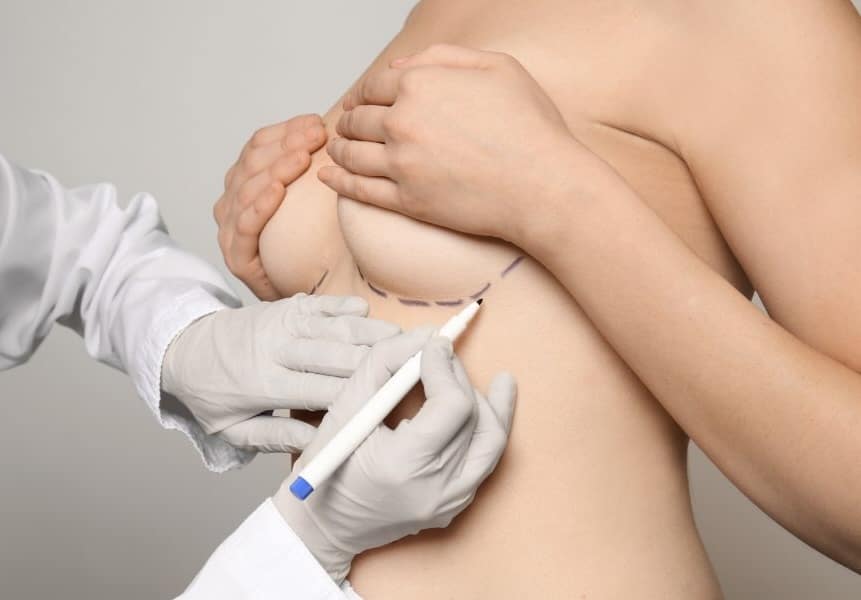How Big Is a Breast Implant Incision?
Written by: Dr. Dahlia Rice. Posted in: Blog

Patients are often concerned about the size and appearance of the breast implant incision scars they’ll have following surgery. And of course, there’s no plastic surgeon who likes scars either.
But what’s important to remember when considering breast augmentation surgery is that scars are simply inevitable. We wish there was a way to achieve great breast augmentation results without the need for incisions, but unfortunately, this has not been developed yet. So, until then, all breast augmentations are performed with incisions.
The good news is that scars do fade. Even incisions made through the delicate breast tissue and skin should close nicely if they are made cleanly and closed carefully and professionally by a skilled and qualified plastic surgeon.
Moreover, time is on our side. As the weeks, months, and years pass, you’ll see your breast implant scars fade more and more.
With all of that said, however, we certainly understand if you still have questions about breast augmentation incisions and scarring. So in this article, we’ll go into more detail about where implant incisions are typically located, how big these incisions are, and what to know about the healing process.
Table of Contents
ToggleBreast Implant Incisions: What to Know
First, let’s talk about what a breast augmentation can achieve as patients often confuse this procedure with breast lift surgery.
What Is Breast Implant Surgery?
Surgery for breast implants, also known as breast augmentation, is a plastic surgery that is performed to increase the volume of a woman’s breasts. Loss of breast volume can occur due to aging, pregnancy and breastfeeding, weight fluctuations, or a combination of these factors.
Many women are simply born with small breasts, and it has always been a goal of theirs to increase the size of their breasts.
Breast implants are the main way that breast size is increased. Some plastic surgeons will also perform breast augmentation fat transfer procedures, but it’s important to note that these procedures cannot achieve a significant breast volume increase.
Usually, patients can only go up about a half of a cup size to one full cup size with fat transfer procedures whereas breast implants can achieve much larger volume increases. Your surgeon will help you choose the right breast implant size.
Implant Incision Locations
Naturally, because saline or silicone implants are used to increase volume size in the breasts, we must have an opening on or near the breasts where we can insert the implants.
These openings are made via incision, and there are three main locations where implant incisions can be made: around the areola (periareolar incision), beneath the breast in the inframammary fold (inframammary incision), or in the armpit (transaxillary incision).
In addition, sometimes, a TUBA (trans umbilical breast augmentation) incision may be made in the belly button. However, the trans umbilical incision is rather difficult and rare.
Implant placement is based on the patient’s goals for surgery and what the surgeon suggests as the best course of action. An armpit incision or TUBA incision location may seem great to patients because the scars can be well-hidden, but implant insertion can be more difficult with these options. Typically, an inframammary incision or periareolar incision is chosen.
Implants are normally placed in a pocket either behind the breast tissue and over or under the pectoral muscle.
Breast Implant Scars
Your implant scars will be located wherever incisions were made. In order for them to heal properly, it’s important that you follow your implant recovery instructions.
Your incision sites will be bandaged, and you will be taught how to keep them clean and dry. Your surgeon will check them periodically as you heal.
Incision Size of Breast Implants
Most implant incisions are around three to five centimeters long, or sometimes, slightly longer. Each incision needs to be long enough for your surgeon to insert the implant. Silicone gel implant incisions are normally slightly larger compared to silicone implants as these can be filled after placement.
Will Breast Implant Scars Go Away?
Over time, incision sites and scars will fade and flatten. Likewise, areola incisions should blend nicely into the pigment of the areolae, and inframammary incisions should be well-hidden in the shadow and fold of the breasts.
 FAQ: Breast Implant Scars & Incisions
FAQ: Breast Implant Scars & Incisions
Is my breast augmentation incision healing correctly?
Within two to four weeks, most patients will have incisions that are fully closed and beginning to fade. Significant fading will not happen for several months, however.
Before this time, your incisions will be sutured together and bandaged to keep them clean and dry. Any significant increases in swelling, redness, pain, or bruising should be conveyed to your doctor.
Bleeding is also a warning sign as is a significant increase in discharge. Normal swelling, bruising, slight redness, and soreness is to be expected.
If you have questions about how your breast augmentation incisions are healing, do not hesitate to contact your surgeon.
What if I get a breast augmentation incision infection?
Signs of infection include heat (to the touch) and intense redness radiating from the wound, an elevated body temperature (fever), increased swelling, excessive drainage, pain, feelings of coldness or shivering, and/or uneven swelling.
If you have serious worries about a possible infected incision site, contact your plastic surgeon immediately. Though potentially graphic, you can also look up breast augmentation incision infection pictures to see examples of what infections look like.
What are the risks of breast implants?
Breast implants carry risks like implant rupture, capsular contracture, infection, changes in nipple sensation, asymmetry, and the potential need for revision surgery or implant removal.
How long do breast implant incisions take to heal?
4-6 weeks is generally the amount of time it takes for the incisions to heal. Avoid strenuous activities, heavy lifting, and overexertion to ensure proper healing during this critical phase.
How long after getting implants can wear a bra?
Typically, women can wear bras 4-6 weeks post-procedure, but it varies with implant type. Surgeons advise waiting three months post-surgery to buy new bras. You will need to wear a compression bra after your augmentation surgery.
Book a Consultation With Dr. Rice Today
To learn more about the breast augmentation procedure, breast augmentation incisions, and whether you are a good candidate for surgery, please set up a consultation appointment.
Once you are cleared for surgery, you can discuss more about whether you want silicone breast implants or saline implants, a periareolar incision or a breast fold incision, and other important decisions for your surgery.
As an experienced plastic surgeon who is board certified, Dr. Dahlia Rice has performed countless breast augmentation procedures in addition to other types of breast enhancement surgery for patients at her Chicago practice. Call today to schedule a consultation.

 FAQ: Breast Implant Scars & Incisions
FAQ: Breast Implant Scars & Incisions